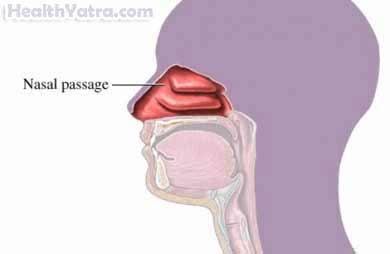परिभाषा
Nosebleed refers to blood flowing from the nose or nasal passage. There are two types of nosebleeds:
- Anterior nosebleed—Blood comes from the front of the nose. It usually flows from the semi-rigid walls that separate the two nostrils. This is the most common type of nosebleed.
- Posterior nosebleed—Bleeding starts deep within the nose. This is often more severe and difficult to treat than an anterior nosebleed.

का कारण बनता है
कारणों में शामिल हैं:
- Irritating or breaking the lining of the nose
- Injuring the nasal tissue, which occurs more easily when nasal structure is not normal, or when the passages are inflamed due to a cold or allergies
- Having very dry nasal tissue
- Picking or bumping the nose
- Forcefully blowing or rubbing the nose
- Having clot from a previous nosebleed becoming disturbed or dislodged
- Placing a foreign object in the nose
- Having a tumor in the nose and/or sinuses
जोखिम कारक
Factors that may increase your risk of nosebleeds include:
- Irregularity in the structure of the nose
- Abnormalities of the blood vessels in the nose (angiomas)
- Dry climate
- Dry, heated indoor air
- एलर्जी
- Colds
- साइनसाइटिस
- Diseases (such as sarcoidosis or lupus)
- कोकीन का सेवन
- रक्तस्राव या थक्के विकार
- Anticoagulant (blood-thinning) drugs, including aspirin
- Very high blood pressure
लक्षण
Nosebleed symptoms depend on where in the nose the bleeding begins, for example:
- Anterior nosebleed—These produce blood flow from one nostril when sitting or standing. Blood may pass down the throat if you are coughing or tipping your head back.
- Posterior nosebleed—These cause bleeding down the back of the mouth and throat. Blood may flow from the nostril if you lean forward.
मुझे अपने डॉक्टर को कब बुलाना चाहिए?
Call your doctor if:
- There is a lot of blood.
- The bleeding will not stop.
- The bleeding is caused by an injury.
- You experience frequent nosebleeds.
निदान
आपका डॉक्टर आपके लक्षणों और चिकित्सा इतिहास के बारे में पूछेगा। वह एक शारीरिक परीक्षण करेगा।
Your doctor may want to do certain tests, such as:
- Sinus x-rays—to identify abnormalities or a mass in the nasal region
- Endoscopy—to examine nasal tissues
- Blood tests—to check for anemia, low blood platelets, or clotting problems
उपचार
Most anterior nosebleeds stop without medical care within 15 minutes. Posterior nosebleeds usually are more serious and need medical care. Treatment may include sealing off the blood vessel that is bleeding.
Self-Care
- Stay calm.
- Sit up and lean forward.
- Pinch the soft parts of your nose together. Hold for at least five minutes without releasing pressure.
- Once the bleeding stops, do not pick or blow your nose.
- Avoid straining, bending, or lifting.
- If the bleeding starts again, reapply pressure for ten minutes.
Medical Intervention
For an anterior nosebleed, your doctor will use a compress soaked in a medicine. The medicine constricts or shrinks the blood vessel and reduces the pain. Pressure will be applied by pinching the nostrils together. Your doctor may pack the area with gauze. In more severe cases, your doctor may cauterize (seal off) a blood vessel that does not clot on its own.
A posterior nosebleed may require packing the nostril or inserting and inflating a special balloon that applies pressure to the area. If all medical attempts to control bleeding fail, surgery may be needed.
If you are diagnosed with a nosebleed, follow your doctor’s instructions.
रोकथाम
To reduce the chance of getting a nosebleed:
- Lubricate dry nasal passages near the front of the nose. Place a small dab of lubricating cream or ointment on your fingertip. Apply the lubricant to the inside of the nose. You may do this at bedtime or up to three times during the day. Polysporin and petroleum jelly (such as Vaseline) are examples of lubricants that may be used.
- Use a saline nasal spray. These help keep nasal passages moist. Be sure that the nose spray does not contain medicines such as phenylephrine or oxymetazoline. These types of medicines should be used for only a few consecutive days.
- Do not pick your nose. Cut children’s fingernails short to discourage picking.
- Humidify the air, especially in bedrooms.
